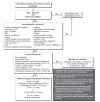Risk-assessment algorithm and recommendations for venous thromboembolism prophylaxis in medical patients
- PMID: 17969384
- PMCID: PMC2291339
Risk-assessment algorithm and recommendations for venous thromboembolism prophylaxis in medical patients
Abstract
The risk for venous thromboembolism (VTE) in medical patients is high, but risk assessment is rarely performed because there is not yet a good method to identify candidates for prophylaxis.
Purpose: To perform a systematic review about VTE risk factors (RFs) in hospitalized medical patients and generate recommendations (RECs) for prophylaxis that can be implemented into practice.
Data sources: A multidisciplinary group of experts from 12 Brazilian Medical Societies searched MEDLINE, Cochrane, and LILACS.
Study selection: Two experts independently classified the evidence for each RF by its scientific quality in a standardized manner. A risk-assessment algorithm was created based on the results of the review.
Data synthesis: Several VTE RFs have enough evidence to support RECs for prophylaxis in hospitalized medical patients (eg, increasing age, heart failure, and stroke). Other factors are considered adjuncts of risk (eg, varices, obesity, and infections). According to the algorithm, hospitalized medical patients > or =40 years-old with decreased mobility, and > or =1 RFs should receive chemoprophylaxis with heparin, provided they don't have contraindications. High prophylactic doses of unfractionated heparin or low-molecular-weight-heparin must be administered and maintained for 6-14 days.
Conclusions: A multidisciplinary group generated evidence-based RECs and an easy-to-use algorithm to facilitate VTE prophylaxis in medical patients.
Figures
Similar articles
-
Interventions for implementation of thromboprophylaxis in hospitalized patients at risk for venous thromboembolism.Cochrane Database Syst Rev. 2018 Apr 24;4(4):CD008201. doi: 10.1002/14651858.CD008201.pub3. Cochrane Database Syst Rev. 2018. PMID: 29687454 Free PMC article.
-
Pharmacological interventions for preventing venous thromboembolism in people undergoing bariatric surgery.Cochrane Database Syst Rev. 2022 Nov 22;11(11):CD013683. doi: 10.1002/14651858.CD013683.pub2. Cochrane Database Syst Rev. 2022. PMID: 36413425 Free PMC article.
-
Unfractionated heparin versus low molecular weight heparins for avoiding heparin-induced thrombocytopenia in postoperative patients.Cochrane Database Syst Rev. 2017 Apr 21;4(4):CD007557. doi: 10.1002/14651858.CD007557.pub3. Cochrane Database Syst Rev. 2017. PMID: 28431186 Free PMC article.
-
Screening for thrombophilia in high-risk situations: systematic review and cost-effectiveness analysis. The Thrombosis: Risk and Economic Assessment of Thrombophilia Screening (TREATS) study.Health Technol Assess. 2006 Apr;10(11):1-110. doi: 10.3310/hta10110. Health Technol Assess. 2006. PMID: 16595080
-
Neuromuscular electrical stimulation for the prevention of venous thromboembolism.Cochrane Database Syst Rev. 2017 Nov 21;11(11):CD011764. doi: 10.1002/14651858.CD011764.pub2. Cochrane Database Syst Rev. 2017. PMID: 29161465 Free PMC article.
Cited by
-
Prophylaxis of venous thromboembolism in medical patients: too much or too little?Clin Epidemiol. 2012;4:315-8. doi: 10.2147/CLEP.S38304. Epub 2012 Nov 15. Clin Epidemiol. 2012. PMID: 23204871 Free PMC article.
-
Development of a Risk Model for Pediatric Hospital-Acquired Thrombosis: A Report from the Children's Hospital-Acquired Thrombosis Consortium.J Pediatr. 2021 Jan;228:252-259.e1. doi: 10.1016/j.jpeds.2020.09.016. Epub 2020 Sep 10. J Pediatr. 2021. PMID: 32920105 Free PMC article.
-
Risk-assessment models for predicting venous thromboembolism among hospitalized non-surgical patients: a systematic review.J Thromb Thrombolysis. 2013 Jan;35(1):67-80. doi: 10.1007/s11239-012-0780-0. J Thromb Thrombolysis. 2013. PMID: 22826096
-
Deep venous thrombosis after Achilles tendon rupture is associated with poor patient-reported outcome.Knee Surg Sports Traumatol Arthrosc. 2020 Oct;28(10):3309-3317. doi: 10.1007/s00167-020-05945-2. Epub 2020 Apr 20. Knee Surg Sports Traumatol Arthrosc. 2020. PMID: 32313988 Free PMC article.
-
PROF-ETEV study: prophylaxis of venous thromboembolic disease in critical care units in Spain.Intensive Care Med. 2014 Nov;40(11):1698-708. doi: 10.1007/s00134-014-3442-1. Epub 2014 Aug 20. Intensive Care Med. 2014. PMID: 25138229
References
-
- Abdollahi M, Cushman M, Rosendaal FR. Obesity: risk of venous thrombosis and the interaction with coagulation factor levels and oral contraceptive use. Thromb Haemost. 2003;89(3):493–498. - PubMed
-
- Agraharkar M, Isaacson S, Mendelssohn D, et al. Percutaneously inserted silastic jugular hemodialysis catheters seldom cause jugular vein thrombosis. ASAIO J. 1995;41(2):169–172. - PubMed
-
- Alikhan R, Cohen AT, Combe S, et al. Risk factors for venous thromboembolism in hospitalized patients with acute medical illness: analysis of the MEDENOX Study. Arch Intern Med. 2004;164(9):963–968. - PubMed
-
- Alikhan R, Cohen AT, Combe S, et al. Prevention of venous thromboembolism in medical patients with enoxaparin: a subgroup analysis of the MEDENOX study. Blood Coagul Fibrinolysis. 2003;14(4):341–346. - PubMed
-
- Anderson FA, Jr, Wheeler HB, Goldberg RJ, et al. The prevalence of risk factors for venous thromboembolism among hospital patients. Arch Intern Med. 1992;152(8):1660–1664. - PubMed
Publication types
MeSH terms
LinkOut - more resources
Full Text Sources


